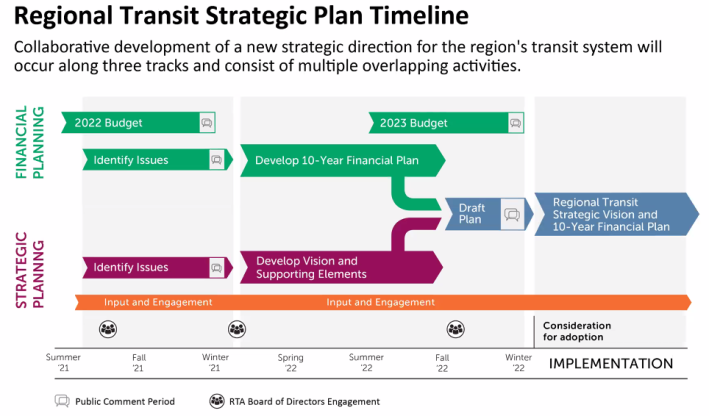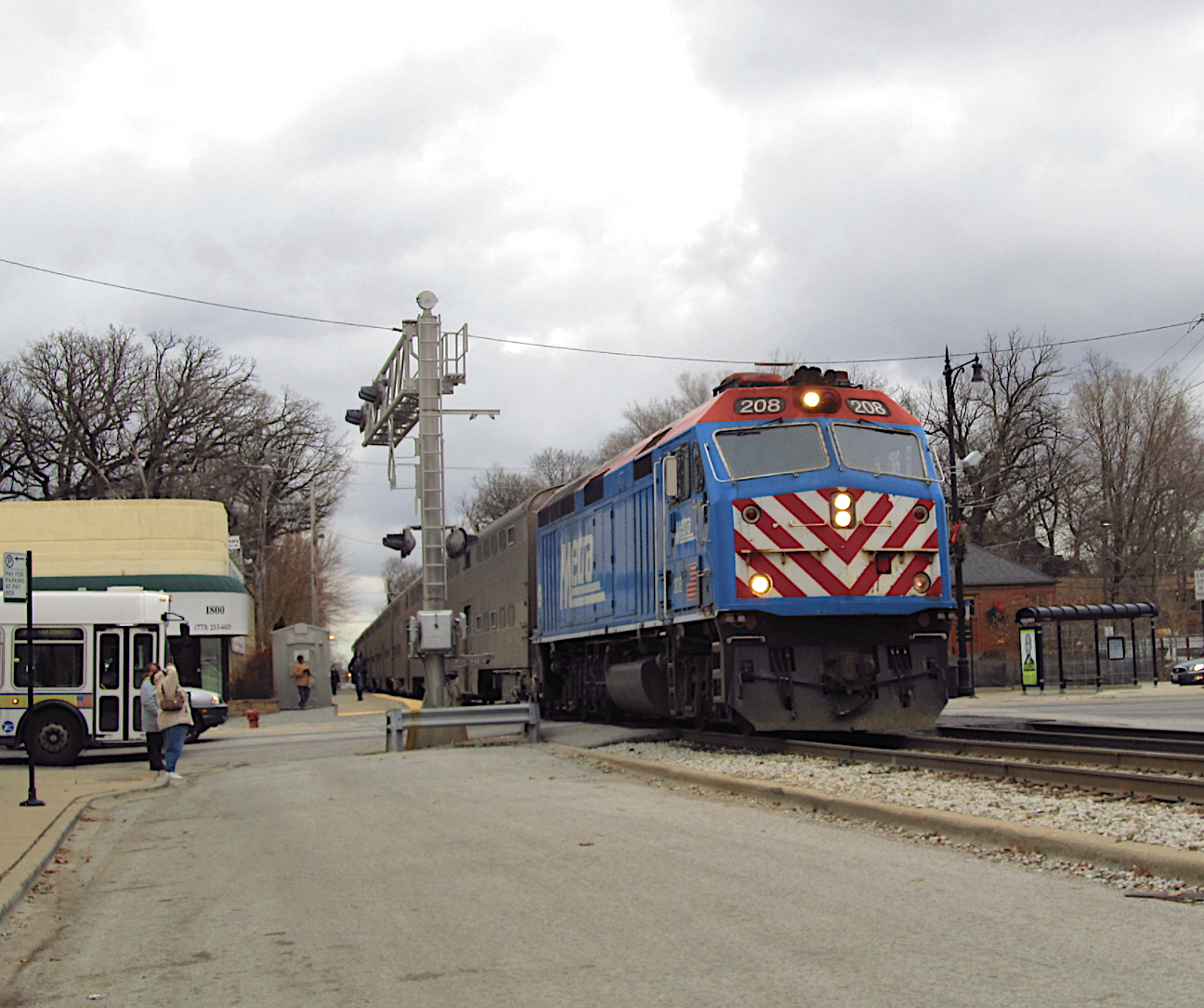Transit advocates are urging the Regional Transportation Authority and the three transit agencies under its oversight to invest more resources in reverse commuting; improve stakeholder participation; and move away from hub-and-spoke centric thinking as Chicagoland emerged from the COVID-19 pandemic.
This fall the University of Illinois at Chicago’s Urban Transportation Center has hosted several virtual panels looking at the future of transportation in the Chicago area. The November 11 “Emerging From Crisis Wiser: Reimagining Regional Transit” forum featured three panelists: David Bragdon, executive director at the TransitCenter, a New York City-based civic foundation that helps municipalities develop better transit; Heidy Persaud, director of transportation equity at the Center for Neighborhood Technology, a Chicago-based economic development and anti-poverty organization; and Bethany Williams, strategy and intelligence director at the Lake County Partners economic development corporation.
This particular forum was organized in collaboration with the RTA, which is gathering input for its upcoming 2023 strategic plan. This August, the RTA began working on the plan, which will set out the agency’s vision for transportation in post-pandemic Chicagoland. The project is in the input-gathering phase, and the November 11 forum was part of that. RTA director of planning and market development Jessica Hector-Hsu moderated the panel.

In her opening remarks, RTA executive director Leanne Redden reflected that the pandemic forced the CTA, Metra, Pace, and the RTA to innovate quickly, something that the transit agencies should continue to do as they consider the post-COVID future, especially in light of the passage of the federal infrastructure bill.
"The task before us is to grow the spirit of innovation and bring longer-lasting change to the transit system,” Redden said. “We understand that transit is a great equalizer, and it's an irreplaceable piece of our mobility system, and enables [movement] in the ways and the scale that [nothing] else can.”
The panelists were asked whether the pandemic changed the way they view public transit, and everyone agreed that it illuminated issues that were already there. Williams said that when Metra and Pace cut service in Lake County, Lake County Partenrs' biggest concern was “losing the culture of ridership that we have had.”
But, on the bright side, the pandemic made Lake County companies more interested in exploring ways to enable reverse commuting. “That was exciting, to see employees push that change. It’s intermeshing about this moment, the sort of collision with the social justice movement and the pandemic hitting at the same time, all of this having an incredibly huge impact on the workforce as individuals.”
Williams added that, starting a few years before the pandemic, Lake County Partners started hearing from companies that wanted to improve transit options for employees. They helped fund the reverse commuting pilot on Metra's Milwaukee District North line, which added an outbound morning express train and two inbound afternoon express trains between Chicago and the stations serving the Lake Cook Road business corridor in Deerfield and Lake Forest. The pilot got sidelined when Metra cut service in the wake of the pandemic. Lake County Partners is also working to create a countywide Dial-a-Ride system, something that Pace provided funding for in its proposed 2022 budget.

TransitCenter's Bragdon said the pandemic drove home the importance of “putting service where people are going to use it, [improving] walkability, connecting [transit] to land use,” and moving away from 9-to-5-centric suburbs-to-downtown, planning, which was already “a vastly outmoded assumption even before the pandemic.”
CNT's Persaud said the pandemic highlighted importance of getting people where they need to go to fulfill their basic needs. She added that it appeared municipalities and planning organizations started taking equity much more seriously than before the crisis.
Persaud added that now is the best to time to capitalize on “a lot of groundwork that’s already being laid” and push for major rethink of the status quo. “Now it's time to be bold. It's the time not to be scared of change. We just need to keep riding the momentum while trying to think of new, innovative ways to move forward.”
Persaud said she would like transit agencies to get more public input beyond what they may hear at a handful of public meetings. This means building relationships with local community organizations in the areas they are looking at, and paying staff members from those organizations for their time. “[Local nonprofits] take the time to provide feedback, without compensation – no consultant would do that. When it comes to more grassroots [input], you need to be able to compensate participation.”
Bragdon said that he would like to remove the silos that separate different transit agencies’ coverage areas. In Chicagoland, this mostly affects railroads that don’t fall under the RTA’s purview. South Shore Line trains and some Amtrak routes don’t transport passengers between Metra stations on rail corridors they share with Metra. He suggested that systems that share routes should at least consider serving each other's stops along the way. “As a [transit] user, you don't care whose bus you're on and whose train you're on – you need to get to work. Take the time to truly think about it from the user’s perspective.”
Asked what the transit agencies can do to make sure transit can get people to jobs outside the urban core, Lake County Partners' Williams said that developing transit needs to be seen as part of the broader economic development and infrastructure improvements. She added that Lake County suburbs are starting to recognize this.
CNT's Persaud said that the issue with transit-orientated development is that the housing it creates tends to be upscale, so “there needs to be more conversations about equitable transit development.” And she argued that it’s not enough to talk about how to get people to work – we need to make sure people can live near and/or have convenient transit access to places where they work.
TransitCenter's Bragdon said moving the planning away from the Loop-centric system could be done, citing Houston as an example of a city that’s “very multi-centric” and where the downtown “is not a huge percentage of employment.” Bus ridership in that city increased significantly after the system was redesigned from a hub-and-spokes network to a grid. “They are able to deploy their transit service in a multimodal way, instead of hub-and-spoke,” Bragdon said.
The panelists were also asked to weigh in on whether reducing fares, with programs like the Fair Transit South Cook pilot that is currently making it cheaper to ride the Metra Electric and Rock Island District routes, would encourage more transit use. Bragdon said that, while there was something to be said for lowering fares for lower-income riders, he didn’t believe fares were the most important factor, but rather service frequency is. “If the train doesn’t stop [where you need to go] and [only] runs every two hours, the fare doesn’t matter,” Bragdon said.
Persaud disagreed, arguing that people who would benefit most from free transit “are not advocating for themselves or not coming to the table,” so transit advocated like Bragdon may be underestimating the demand.
The portions of the Lake County served by the Union Pacific North Metra Line experienced the closest thing to free transit during the pandemic, because Union Pacific Railroad, which runs those routes under a contract with Metra, ordered its conductors to stop collecting fares during COVID, and fare collection didn't resume until this June. While the line saw a higher share of the overall Metra ridership between June 2020 and June 2021 than it did pre-pandemic, it remained the third busiest line – after the BNSF and Union Pacific North Lines – after the railroad started collecting fares again.





